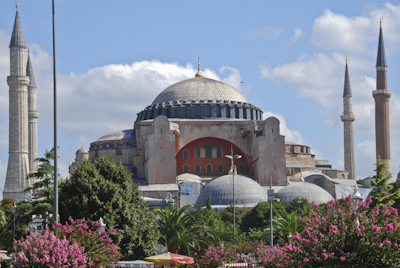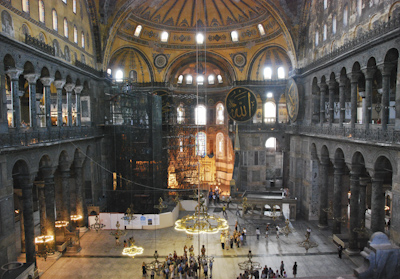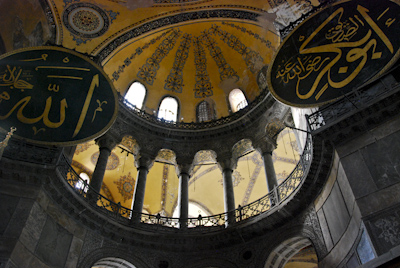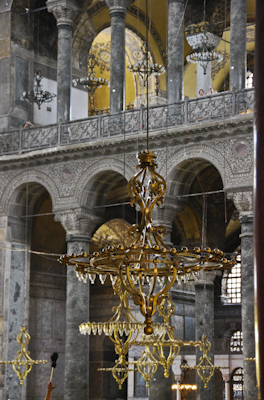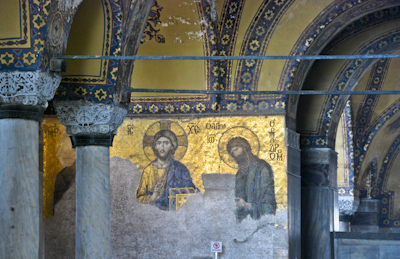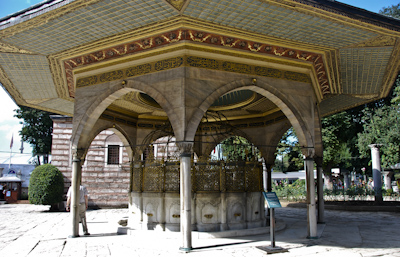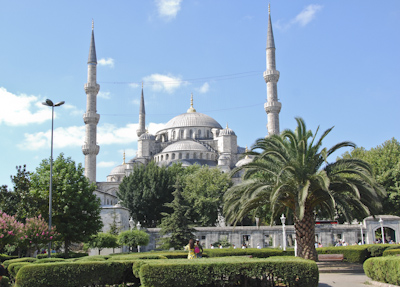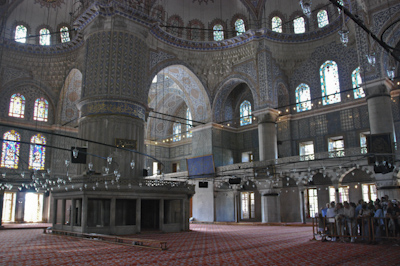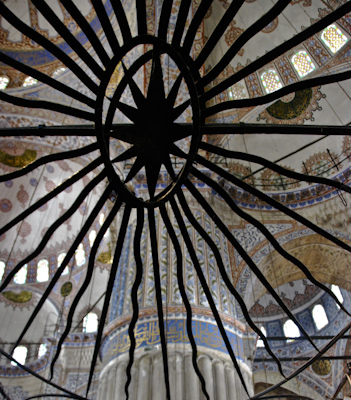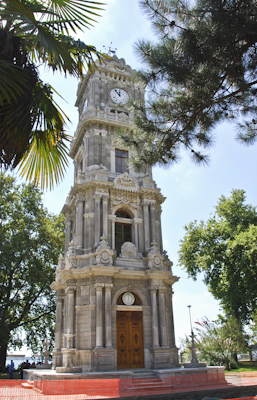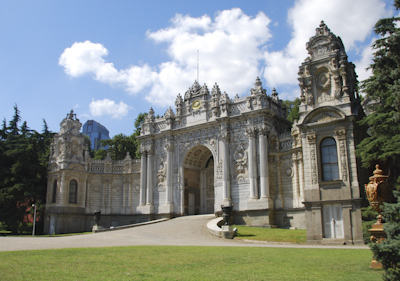Tuesday – August 24
This was our morning to visit the magnificent Haghia Sophia. Chris had suggested revisiting the “church of holy wisdom” at different times of the day to catch the natural light coming in through different windows. He was correct! The light casts different hues and illuminates different parts of the building depending on the time of day. Seeing the building with different lighting is a completely new experience!
View of the East Side of the Nave
In the morning, the end of the building where the alter would have been glows with a warm golden light. The sunlight streams in through huge arched windows making the vast interior look bigger and brighter.
I can’t say enough superlatives about Haghia Sophia. It is magnificent! The building is almost 1,500 years old and is incredibly impressive. One of the guide books said, “Haghia Sophia is among the world’s greatest architectural achievements.” The high central dome reaches to a height of 184 feet and makes the visitor feel very small. It was designed to be a celestial experience.
Not all of the antique chandeliers are electrified. Many of them still have small clear glass cups which must have originally burned oil or candle wax. I tried to imagine the interior of Haghia Sophia illuminated only with burning candles.
Reconstruction and removal of plaster continues throughout Haghia Sophia. It had been converted to a mosque in 1453 and all the images were covered or removed at that time. Today it is a museum and both the Byzantine and Muslim art are being restored.
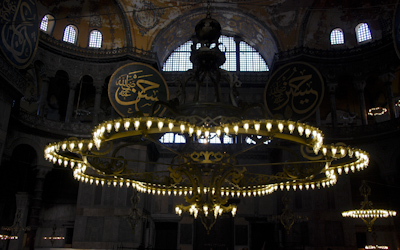 Glowing Chandelier and Roundel
Glowing Chandelier and Roundel
We spent a couple of hours in Haghia Sophia, looking and exploring and taking many photographs. This was my fourth time visiting the magnificent building and it was an amazing experience again. I don’t think I would ever get tired of seeing and experiencing the impressive building.
In the inner courtyard near the exit from Haghia Sophia is the Ablutions Fountain. It was built in 1740 and, according to a guidebook, is an “exquisite example of Turkish Rococo style.” The projecting roof is painted with floral reliefs. We passed through the turn styles at the exit and looked across the park to the Blue Mosque.
We were back out in the brilliant Istanbul sunshine! The park between Haghia Sophia and the Blue Mosque is lovely. Many people: tourists, families, locals walk through the park or sit and enjoy the scenery. There are lovely palm trees and flowers and bushes everywhere. I especially enjoyed the crepe myrtle bushes which were blooming in shades of bright pink.
We walked across the park to the Blue Mosque. Jeff had not seen the interior and he was a little curious. I, of course, love the beautiful Iznik tiles. The mosque is one of the most famous religious buildings in the world. It was commissioned by the Sultan Ahmet I and built between 1609 and 1616 by Mehmet Aga, the imperial architect of the time. Mehmet Aga had been a pupil of Turkey’s celebrated chief royal architect, Mimar Sinan, who was Armenian.
The Blue Mosque gets its name from the predominantly blue and white Iznik tiles which adorn the walls and ceiling of the interior. Iznik pottery was named after the town in western Anatolia where it was made. The pottery manufacturing in Iznik reached its height during the late sixteenth century. The Ottoman sultan, Suleyman the Magnificent (1520-66) is credited with the increased demand for Iznik pottery and tiles.
We put our shoes back on and left the Blue Mosque and went to the tram station on Divanyolu Cadessi. We rode the tram to the last stop and walked a few blocks to Dolmabahce Palace. Chris had visited the Palace one day on his own and he said that it was worth seeing.
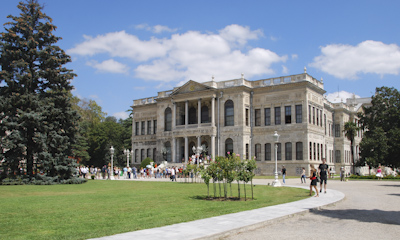 Main Entrance to Dolmabahce Palace
Main Entrance to Dolmabahce Palace
Dolmabahce Palace was built in 1856 by Sultan Abdul Mecit because he thought Topkapi Palace was too small and old fashioned. The architect was Karabet Balyan and his son, Nigogayos, who were members of a family of great Armenian architects who built many opulent palaces along the Bosphorus for wealthy Turkish businessmen and their families. The palace has 285 rooms and 46 halls. The building has an area of 11.2 acres. Photography was not allowed inside the palace, so I only have photos of the beautiful grounds.
The Clock Tower is located just outside the palace walls. It was constructed by the famous Armenian architect, Sarkis Balyan between 1890 and 1895. Like the palace, the Clock Tower is situated along the Bosphorus with beautiful panoramic views of the European and Asian sides of the city of Istanbul.
Dolmabahce Palace was home to six sultans from 1856 to 1924 when the system of government of sultans (Caliphate) was abolished in Turkey. A law transferred the ownership of the palace to the new Turkish Republic in 1924. Mustafa Kemal Ataturk, the founder and first President of the Republic of Turkey, used the palace as a presidential residence during the summers and enacted some of his most important works here. Atatürk spent the last days of his life in the palace, where he died on November 10, 1938. The Turkish people we talked to call it “Ataturk’s house”.
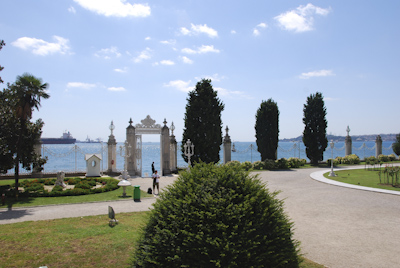 View of Istanbul from the Palace Steps
View of Istanbul from the Palace Steps
There are several very large and impressive rooms in the palace. The world’s largest Bohemian crystal chandelier is in the center hall, which was a gift from Queen Victoria. One of the great staircases, called the Crystal Staircase, has bannisters made of Baccarat crystal. There were other important paintings and works of art throughout the palace. Less impressive were Ataturk’s rooms where he worked and eventually died. There was also a part of the palace where the sultans had their “harem”, but this was disappointing especially after seeing Topkapi Palace. The guide told us that by the late 1800s the sultans had only four to six wives who lived with their children in separate apartments. These apartments were dreary Victorian rooms.
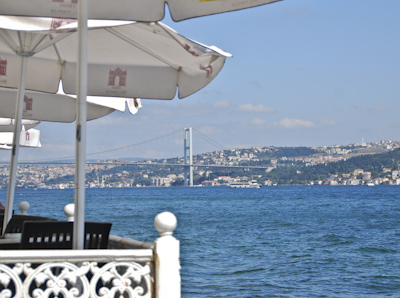 View of Ataturk Bridge to the Asian Side of Istanbul
View of Ataturk Bridge to the Asian Side of Istanbul
We were tired after walking around Dolmabahce Palace and fortunately for us there was a cafe right outside along the Bosphorus. We sat in the shade of an umbrella and had iced teas along the blue water. We enjoyed a lovely breeze and the view of the Asian side of Istanbul. We watched the Turkish boats go by and rested before returning to Sultanahmet on the tram. Istanbul continued to surprise and delight us.
